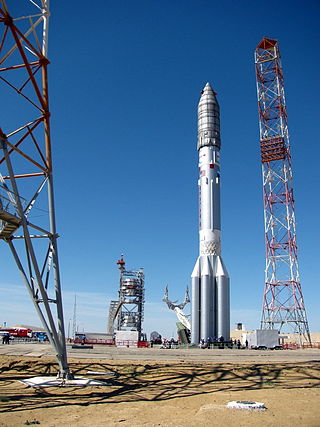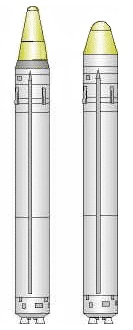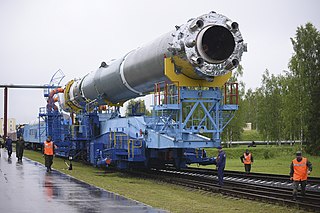Related Research Articles

The RD-58 is a rocket engine, developed in the 1960s by OKB-1, now RKK Energia. The project was managed by Mikhail Melnikov, and it was based on the previous S1.5400 which was the first staged combustion engine in the world. The engine was initially created to power the Block D stage of the Soviet Union's abortive N-1 rocket. Derivatives of this stage are now used as upper stages on some Proton and Zenit rockets. An alternative version of the RD-58 chamber, featuring a shorter nozzle, was used as the N-1's roll-control engine.

The Proton-M, (Протон-М) GRAU index 8K82M or 8K82KM, is an expendable Russian heavy-lift launch vehicle derived from the Soviet-developed Proton. It is built by Khrunichev, and launched from sites 81 and 200 at the Baikonur Cosmodrome in Kazakhstan. Commercial launches are marketed by International Launch Services (ILS), and generally use Site 200/39. The first Proton-M launch occurred on 7 April 2001.

Strela is a Russian orbital carrier rocket, derived from the Soviet/Russian UR-100NU missile. It conducted its maiden test launch on 5 December 2003, carried its first functional payload on 27 June 2013, and a second one on 19 December 2014.

The RD-0124 is a rocket engine burning liquid oxygen and kerosene in an oxygen-rich staged combustion cycle, developed by the Chemical Automatics Design Bureau in Voronezh. RD-0124 engines are used on the Soyuz-2.1b and Soyuz-2-1v. A variant of the engine, the RD-0124A, is used on the Angara rocket family's URM-2 upper stage.

The RD-253 ( Russian: Раке́тный дви́гатель 253, Rocket Engine 253) and its later variants, the RD-275and RD-275M, are liquid-propellant rocket engines developed in the Soviet Union by Energomash. The engines are used on the first stage of the Proton launch vehicle and use an oxidizer-rich staged combustion cycle to power the turbopumps. The engine burns UDMH/N2O4, which are highly toxic but hypergolic and storable at room temperature, simplifying the engine's design.
The RD-120 is a liquid upper stage rocket engine burning RG-1 and LOX in an oxidizer rich staged combustion cycle with an O/F ratio of 2.6. It is used in the second stage of the Zenit family of launch vehicles. It has a single, fixed combustion chamber and thus on the Zenit it is paired with the RD-8 vernier engine. The engine was developed from 1976 to 1985 by NPO Energomash with V.P. Radovsky leading the development. It is manufactured by, among others, Yuzhmash in Ukraine.
The Blok DM-03, GRAU index 11S861-03, is a Russian upper stage used as an optional fourth stage on the Proton-M heavy-lift rocket. Three have been launched, the first in December 2010; the first two launches failed before fourth stage ignition, the first as a result of a problem with the Blok DM's fuel load.

The RD-0110 is a rocket engine burning liquid oxygen and kerosene in a gas generator combustion cycle. It has four fixed nozzles and the output of the gas generator is directed to four secondary vernier nozzles to supply vector control of the stage. It has an extensive flight history with its initial versions having flown more than 57 years ago.

The RD-0110R is a rocket engine burning kerosene in liquid oxygen in a gas generator combustion cycle. It has four nozzles that can gimbal up to 45 degrees in a single axis and is used as the vernier thruster on the Soyuz-2-1v first stage. It also has heat exchangers that heat oxygen and helium to pressurize the LOX and RG-1 tanks of the Soyuz-2.1v first stage, respectively. The oxygen is supplied from the same LOX tank in liquid form, while the helium is supplied from separate high pressure bottles.

The RD-0210 (GRAU Index: 8D411K) is also known as the RD-465. It and its twin, the RD-0211, are rocket engines burning N2O4 and UDMH in an oxidizer rich staged combustion cycle. They have single nozzle, possess TVC and are the latest evolution in the RD-0203/4 lineage. They are the engines used on the Proton second stage. The RD-0213 is a fixed nozzle variation that is used on the RD-0212 module of the Proton third stage.
The RD-0243 is a propulsion module composed of an RD-0244 main engine and a RD-0245 vernier engine. Both are liquid rocket engine, burning N2O4 and UDMH. The RD-0244 main engine operates in the oxidizer rich staged combustion cycle, while the vernier RD-0245 uses the simpler gas generator cycle. Since volume is at a premium on submarine launches, this module is submerged on the propellant tank. Its development period was from 1977 to 1985, having had its first launch on December 27, 1981. Originally developed for the RSM-54, it was used later for the Shtil'.
The RD-0216 and RD-0217 are liquid rocket engines, burning N2O4 and UDMH in the oxidizer rich staged combustion cycle. The only difference between the RD-0216 and the RD-0217 is that the latter has not a heat exchanger to heat the pressuring gasses for the tanks. Three RD-0216 and one RD-0217 were used on the first stage of the UR-100 ICBM. The engines were manufactured until 1974 and stayed in operational use until 1991. More than 1100 engines were produced.
The RD-0233 (GRAU Index 15D95) and RD-0234 (GRAU Index 15D96) are liquid rocket engines, burning N2O4 and UDMH in the oxidizer rich staged combustion cycle. The only difference between the RD-0233 and the RD-0234 is that the latter has a heat exchanger to heat the pressuring gasses for the tanks. Three RD-0233 and one RD-0234 are used on the first stage of the UR-100UTTKh ICBM. While the engine is out of production, the ICBM as well as Rokot and Strela remain operational as of 2015.
The RD-0236 (GRAU Index 15D114) is a liquid rocket vernier engine, burning N2O4 and UDMH in the gas generator cycle. It is used along the RD-0235 main engine on the UTTKh second stage, which was featured in the UR-100N ICBM as well as the Strela and Rokot launch vehicles derived from it. Its function is to supply thrust vector control by gimbaling each of its four nozzles in a plane. While the engine is out of production, the ICBM as well as Strela remain operational as of 2015. The Rokot launch vehicle conducted its final launch before retirement in December 2019.
The RD-0237 (GRAU Index 15D114) is a pressure-fed liquid rocket vernier engine, burning N2O4 and UDMH. It is used on the UR-100UTTKh MIRV vehicle to supply thrust vector control by gimbaling of its nozzle. While the engine is out of production, the ICBM and Strela remain operational as of 2015.
The RD-263 (GRAU Index 15D117) is a liquid rocket engine, burning N2O4 and UDMH in the oxidizer rich staged combustion cycle. Four RD-263 engines form a propulsion module RD-264 (GRAU Index 15D119). For the R-36M KB Yuzhnoye only ordered the first stage propulsion to Energomash, instead of both stages, arguing that they were overworked with the RD-270 development. By April 1970 Yuzhnoye was getting the engine documentation. By the end of 1972 Energomash started to test fire the engines in its own test stand. And by September 1973 the engine was certified for flight. While the engine is out of production, the ICBM as well as the Dnepr remain operational as of 2015.

The RD-119 was a liquid rocket engine, burning liquid oxygen and UDMH in the gas-generator cycle. It has a huge expansion ratio on the nozzle and uses a unique propellant combination to achieve an extremely high isp of 352 s for a semi-cryogenic gas-generator engine. It also has a unique steering mechanism. The engine main nozzle is fixed, and the output of the gas generator is fed into four nozzles on the side of the engine. Instead of using gimbaled verniers to supply vector control, the combustion gases are distributed by an electrically driven system that can control the thrust among the nozzles.
Voronezh Mechanical Plant is a Russian engine and heavy machinery manufacturing plant. It is located in the city of Voronezh, in the Voronezh Oblast.

The RD-250 (GRAU Index 8D518) is the base version of a dual-nozzle family of liquid rocket engines, burning N2O4 and UDMH in the gas-generator open cycle. The RD-250 was developed by OKB-456 for Yangel's PA Yuzhmash ICBM, the R-36 (8K67). Its variations were also used on the Tsyklon-2 and Tsyklon-3 launch vehicles. It was supposed to be used on the Tsyklon-4, but since the cancellation of the project it should be considered as out of production.
The RD-0255 is a propulsion module composed of an RD-0256 main engine and a RD-0257 vernier engine. Both are liquid rocket engine, burning UDMH in N2O4. The RD-0256 main engine operates in the oxidizer rich staged combustion cycle, while the vernier RD-0257 uses the simpler gas generator cycle. It was used on the R-36MUTTKh (GRAU:15A18) and R-36M2 (GRAU:15A18M). Subsequently, it has been in the Dnepr second stage and as of 2016 it is still in active service.
References
- ↑ "RD-0203, RD-0204, RD-0205, RD-0206, RD-0207. Intercontinental ballistic missile UR-200". KBKhA. Archived from the original on 5 May 2014.
- 1 2 3 4 5 6 7 8 9 10 "RD0208, RD0209 Launch Vehicle Proton (8K82H-4 two stages). RD0210, RD0211, RD0212 (RD0213, RD0214) Launch Vehicle Proton (8K82K, 8K82KM three stages)". KBKhA. Archived from the original on 15 August 2015.
- ↑ Pillet, Nicolas. "Le troisième étage du lanceur Proton" (in French). Kosmonavtika.com. Retrieved 2015-06-08.
- 1 2 3 4 5 6 7 8 Zak, Anatoly. "RD-0212 engine". www.russianspaceweb.com. Retrieved 2015-06-08.
- 1 2 3 "RD-0207". Encyclopedia Astronautica. Archived from the original on June 25, 2002. Retrieved 2015-06-08.
- 1 2 Zak, Anatoly. "UR-200 / 8K81 / SS-X-10". www.russianspaceweb.com. Retrieved 2015-06-08.
- 1 2 "UR-200". Encyclopedia Astronautica. Archived from the original on May 2, 2002. Retrieved 2015-06-08.
- ↑ Zak, Anatoly. "Birth of Proton: The Iconic Rocket That Almost Wasn't". www.russianspaceweb.com. Retrieved 2015-06-08.
- ↑ Zak, Anatoly. "Proton's second stage". www.russianspaceweb.com. Retrieved 2015-06-08.
- ↑ Zak, Anatoly. "Proton's third stage". www.russianspaceweb.com. Retrieved 2015-06-08.
- 1 2 3 "KBKHA LIQUID ROCKET ENGINES, WHICH ENSURED THE SUCCESSFUL REALIZATION OF THE ADVANCED SPACE PROGRAMS (FOR THE FIRST TIME IN THE WORLD)". KBKhA. Archived from the original on 15 August 2015.
- ↑ "RD-0214". Encyclopedia Astronautica. Archived from the original on June 25, 2002. Retrieved 2015-06-08.
- ↑ "RD-0205". Encyclopedia Astronautica. Archived from the original on August 26, 2002. Retrieved 2015-06-08.
- ↑ "RD-0212". Encyclopedia Astronautica. Archived from the original on June 2, 2002. Retrieved 2015-06-08.
